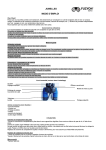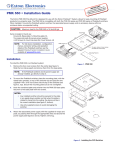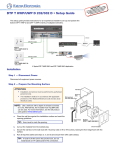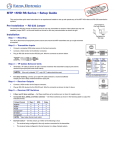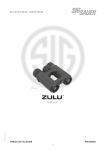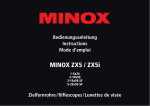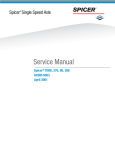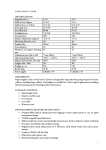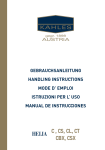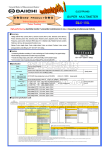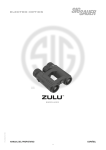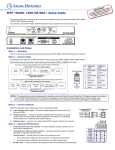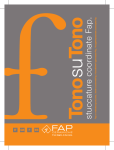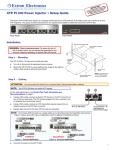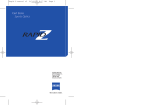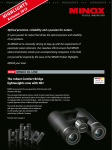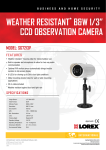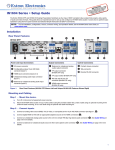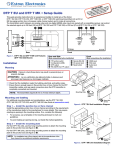Download Untitled
Transcript
N at u r e g i v e s e v e r y c r e at u r e a s e c r e t w e a p o n . You’ve been in the woods before, but this time it will be different. Now you are equipped with the power and vision to reveal what nature has hidden. Now you have an advantage. With OCULUS®, your patience and skill will pay off like never before. Through shadows and glare to the morning fog, mist, and rain, you will experience the outdoors in a whole new way, and improve your chances of getting what you came for. O c u l u s B I N OCULAR Pa r t s G u i d e 5.0 Model B F In s t r u c t i o n s f o r u s e Utilizing the Neck Strap Adjusting the binoculars for use – Hold Once the Neck Strap (H) is attached to the the binoculars with a barrel in each hand and the binoculars, it can be used to hold the Eyepiece Twist-Up Eyecups (C) toward your eyes. If you are Lens Cover (J) while the binoculars are in use. wearing glasses, twist the Twist-Up Eyecups (C) A clockwise so that they are in the lowest position. C D If you do not wear eyeglasses, adjust the Twist-Up Eyecups (C) counterclockwise so that they are in H the highest position. While looking through the binoculars at a stationary object about 100 yards away, adjust E the Center Hinge (F) by moving the barrels of the binoculars together or farther apart until the A–Center Focus Knob B–Diopter Adjustment C–Twist-Up Eyecup D–Tripod Mount E–Objective Lens F–Center Hinge 3 interpupillary distance (the distance between the individual barrels of the binoculars) provides you with a view through the binoculars that appears as a single circular field. J 4 In s t r u c t i o n s F o r U s e G e n e r a l In f o r m at i o n Cleaning the Binoculars Cover the right objective lens with the Objective Lens Cover (G) and, while keeping both eyes binoculars. The binoculars are now adjusted to the Note – The diopter setting will vary from one user open, look through the left side of the binoculars variance in the vision of your individual eyes and to the next; however, once you have the diopter with your left eye and use the Center Focus Knob can now be focused simply by using the Center set for your eyes, you should not have to set it (A) to focus the left side of the binoculars on a Focus Knob (A). again unless it is moved out of adjustment. Remove any loose dust or dirt with a blower and clean the exterior body with a soft clean cloth. If the lenses become dirty, it is very important that they are cleaned first with a soft brush and then wiped clean with the provided lens cloth. stationary object about 100 yards away. (Note Use caution not to damage the lenses or the lens that it is important to keep both eyes open for this Lens Covers – The lenses of the binoculars exercise – do not close the right eye). Once this are protected from dirt by protective caps. The is complete, without touching the Center Focus caps need to be removed from the lenses prior to Storage Knob (A), remove the Objective Lens Cover (G) use. Note that the Objective Lens Covers (G) can Before storing your binoculars, be sure that they from the right side Objective Lens (E) and cover be completely removed (and stored separately the left Objective Lens. With both eyes open, look from the binoculars) or can remain attached through the binoculars at the same stationary to the bottom of the binocular frame, allowing object used earlier in this process and focus the convenient access when needed yet keeping them right side using the Diopter Adjustment (B). Once out of view when the binoculars are in use. coatings while cleaning the optics. are completely dry, then store them in a cool, dry place. Do not keep binoculars in a vehicle on a hot/sunny day or near any heat source as this may cause damage. the right side is in focus, remove the Objective Lens Cover (G) and look through both sides of the G 5 6 Tech Specs Technical Specs FOV @ 1000 yds. (ft.) (diameter/distance) 8x 430 Polymer 10x 5.0–12x56 Polymer 5.0–15x56 Polymer Eye Relief (mm) Close Focus (ft.) Weight (oz.) Height (in.) Objective Diameter (mm) 5.2/17.2 18 6.6 28.9 5.6 42 341 5.2/17.2 15.5 6.6 27.3 5.6 42 12x 289 4.7/16 15.7 9.8 38.1 6.2 56 15x 236 3.8/15.2 15 15 44.8 7.4 56 Frame Material Magnification 5.0–8x42 Polymer 5.0–10x42 Model # Exit Pupil (mm) 7 For more product information and to register your Oculus® product go to w w w. o c u l u s o p t i c s . c o m 8 M i s s a b s o l u t e ly n o t h i n g . 15x56 12x56 8x42 | 10x42 E N TRETIE N ET SP É CIFICATIO N S Spécifications techniques Poids (g) Hauteur (mm) Diamètre d’objectif (mm) 6.6 819 142 42 15.5 6.6 775 142 42 4.7/16 15.7 3 1080 158 56 3.8/15.2 15 3.8 1270 188 56 Champ visuel Pupille de sortie Accommodation Focale proche à 914,4 m (mm) oculaire (m) (m) (diameter/distance) (mm) Modèle Matériau du armature Grossissement 5.0-8x42 Polymère 8x 131 5.2/17.2 18 5.0-10x42 Polymère 10x 104 5.2/17.2 5.0-12x56 Polymère 12x 88 5.0-15x56 Polymère 15x 72 7 Pour des renseignements supplémentaires et pour enregistrer votre produit OculusMD adressez-vous à w w w. o c u l u s o p t i c s . c o m 8 MODE D ’ EMPLOI RE N SEIG N EME N TS G É N É RAU X Nettoyer les jumelles Couvrez l’objectif droit avec le capuchon pour objectif (G) et, en gardant vos deux yeux ouverts, les deux côtés des jumelles. Les jumelles sont Remarque – Le réglage dioptrique sera différent regardez du côté gauche des jumelles avec votre maintenant adaptées pour les différences de d’une personne à l’autre, toutefois une fois œil gauche et utilisez la mise au point centrale (A) vision de distances pour vos yeux et utilisez le la dioptrie adaptée pour vos yeux, vous ne pour régler la focale du côté gauche en prenant bouton de mise au point (A) pour régler la focale. devriez pas avoir à la régler de nouveau sauf si mire sur un objet immobile à 91,44 mètres. Enlevez la poussière et les saletés de surface avec un pinceau soufflant et nettoyez l’extérieur du corps avec un chiffon doux propre. Si les lentilles sont sales, c’est très important de les nettoyer d’abord avec un pinceau et de les essuyer ensuite l’accommodation s’était déréglée. (Remarque : il est très important de garder les CAPUCHONS POUR LENTILLES – Les lentilles deux yeux ouverts pour cet exercice – ne fermez des jumelles sont protégées contre la poussière pas l’œil droit). Une fois terminé et sans toucher la avec des capuchons protecteurs. On doit retirer mise au point centrale (A), retirez le capuchon (G) les capuchons avant d’utiliser les jumelles. Il est qui couvre l’objectif droit (E) et couvrez l’objectif possible d’enlever complètement les capuchons gauche. Avec les deux yeux ouverts, regardez (G) (et de les ranger séparément) ou ils peuvent dans les jumelles au même objet immobile que rester attachés sous les jumelles ce qui permet précédemment et faites la mise au point du côté un accès facile lorsqu’on en a besoin tout en les droit avec le réglage dioptrique (B). Une fois la mettant de côté lorsqu’on utilise les jumelles. avec le chiffon de nettoyage optique fourni. Faites attention de ne pas endommager les lentilles et les couches de traitement lorsque vous nettoyez les optiques. Rangement Avant de ranger vos jumelles, vérifiez qu’elles sont entièrement sèches puis rangez les dans un endroit frais et sec. Ne laissez pas les jumelles dans un véhicule par temps chaud et ensoleillé ou près d’une source de chaleur ce qui pourrait mise au point du côté droit terminée, retirez le causer des dommages. capuchon pour objectif (G) et regardez dans G 5 6 N OME N CLATURE DES J UMELLES OCULUS MODÈLE 5.0 B F MODE D ’ EMPLOI Utiliser la bandoulière MISE AU POINT DES JUMELLES – Tenez vos Une fois la bandoulière (H) attachée aux jumelles, jumelles par les deux tubes, un dans chaque main on peut l’utiliser pour y accrocher le capuchon et les œilletons (C) tournés vers vos yeux. Si vous pour oculaire (J) lorsqu’on se sert des jumelles. portez des lunettes, tournez les œilletons (C) A dans le sens horaire pour qu’ils soient le plus bas C D possible. Si vous ne portez pas de lunettes, réglez les œilletons (C) dans le sens horaire inverse pour H qu’ils soient le plus haut possible. En regardant dans les jumelles à un objet immobile à une distance d’environ 91,44 mètres, réglez E l’articulation de l’axe central (F) en rapprochant ou en écartant les tubes jusqu’à ce que l’écart A– Mise au point centrale B– Réglage dioptrique C– Œilleton adaptable D– Monture trépied E– Lentille d’objectif F– Articulation de l’axe central 3 interpupillaire (la distance entre les deux tubes des jumelles) produise un seul champ visuel circulaire. J 4 LA N ATURE DO N N E U N E ARME SECRETTE À TOUTE CR É ATURE Ce n’est pas la première fois que vous êtes dans les bois, mais cette fois ce sera différent. Maintenant vous êtes bien équipé en pouvoir et en vision pour révéler ce que la nature nous cache. Maintenant vous avez un avantage. Avec OculusMD, votre patience et votre habileté seront récompensées plus que jamais auparavant. Au travers des ombres et éblouissement de la brume matinale, brouillard et pluie, vous allez ressentir le plein air d’une toute nouvelle manière et améliorer la possibilité OSC-130-742 d’obtenir ce que vous recherchiez.












